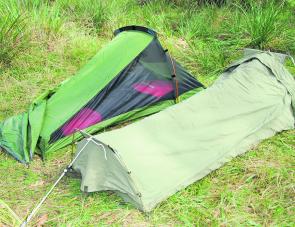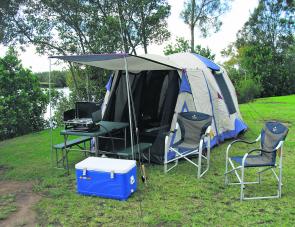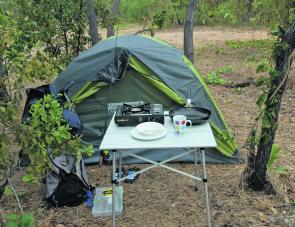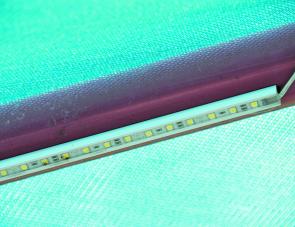Traditionally this isn’t a bad time to go camping – if you prepare for the colder weather and as long as you go about things the right way.
Preparation is everything, so let’s look at some simple comfort issues first.
Whether the campsite revolves around a caravan, camper trailer, a tent or merely a couple of swags under a tarp, we all strive for high comfort levels.
When setting up a ‘home away from home’, a few metres of shadecloth on the ground will ensure that things stay as clean as possible. Shadecloth is great stuff for camping; tent pegs don’t harm it much and it can be swept periodically to remove accumulated grass and sand. What’s more, it can be hosed down at home before the next excursion.
Camping with tents demands that a fly should be set up to provide extra protection against the sun and rain and it also provides a layer of insulation against the cold. ‘
Yet a fly of any sort is only as good as the ropes and poles keeping it upright. It pays to check your rope stays to ensure they are in good condition, not frayed or devoid of any means of tightening them correctly.
Tent poles have a particular weakness in those small bolts and wing nuts on their adjusting collars. If a wing nut or bolt is missing, the pole is unable to be locked at a chosen length and therefore becomes useless. Check them all before you leave and carry a couple of spares in case of accidental damage.
When the tent fly is being set up, a turn or two of rope around the end of a pole, over the top of the usual loop, will ensure that the rope cannot lift off during a sudden strong wind gust.
Likewise, if a really large fly is involved in the camp it will be wise to have a well-braced and fairly rigid cross rope running under the middle of it to take some of the strain off the support poles around the perimeter. Alternatively, there are some quite strong extendable ridge poles to provide extra support.
The main camping gear should also be given prior inspection.
Air mattresses can be inflated at home to see if they stay inflated. Patches will work to seal holes, which can be located using soapy water over the mattress and looking for the bubbles to locate the puncture.
At this time of year it’s important to ensure that your sleeping bag provides the warmth you need for a comfortable night’s sleep. Most good bags sold these days come with a temperature rating and it makes more than good sense to ensure the rating is well in excess of the likely overnight temperatures. Even though there are some great synthetic insulation materials, many of the best Winter sleeping bags are still filled with 100% goose down – but you have to pay for it.
Sleeping bags can have zipper problems but a rub over with candle wax will usually take care of recalcitrant zips.
Camping tables and chairs are usually pretty reliable items but some lubricant on table fittings can’t go astray, nor would a long, hard look at each chair to ensure that it will last the distance.
Anysign of weakness in a chair’s framework or fraying of material should mean it heads to the bin. I once had to spend a week sitting on the icebox when a chair failed me!
Portable lighting is essential for camping and there are many styles available.
Gas lights and portable fluoro lights seem to be losing popularity these days, in favour of the LED light units. Portable LEDs of old were inclined to be a bit dull but today’s versions are stars of the show.
One of the best set-ups around (and I’ve tried my fair share of lights over the years) is the Korr Lighting four-bar LED kit. With 690 Lumens per 50cm bar, these slim but powerful lights have terrific output, absolutely minimal 12V power usage and come complete with dimmers so you can control output where children might be sleeping, or to avoid upsetting neighbours in camping grounds.
These Korr four-bar kits come with velcro or magnetic fittings to provide ample attachment options. These light bars will work under water, so a bit of rain certainly won’t worry them.
The versatility of the four-bar set-up allows lighting to be established over a large area if necessary, thanks to ample connecting wiring.
A standard gas stove, with its hose and accompanying gas bottle, has probably been a mainstay for most of us. However, single- or dual-burner butane canister stoves are very popular these days; they are highly portable and very cheap to run.
Nevertheless, there is one issue to consider when using these butane canister stoves. If camping at higher altitudes and colder conditions, the stove’s jets will tend to freeze up as the butane turns from liquid to gas, causing a very marked reduction in flame height and heating efficiency.
So if heading to the high country, a gas or Shellite stove might be a wiser alternative. I’ve used a Shellite stove in –8º without a problem.
Grass adjoining creeks and rivers will likely still harbour a very population of nasty little biting midges. These fellows, as distinct from coastal sandflies, are strictly paddock or mountain dwellers are smaller than their coastal counterparts, so they can easily sneak through the fly screen mesh of a lot of tents.
To tell if the little biters are around, take a look at any animals nearby; if they are flicking ears or swishing tails continually, the midges are on the job.
The best means of counteracting these critters is to use a powerful personal insect repellent. While citronella candles or mossie coils might deter them a little, an application of Bushman will keep them away far more successfully. ‘Coastal midges are more easily deterred with Aerogard but Bushman is tops. Remember not to spray Bushman or Aerogard on the mesh of a tent because it will react with the synthetic fabric and make it deteriorate fairly rapidly.
A stay outdoors can be a treat at this time of year, just make the right preparations and pick the best area possible when setting up camp. For me, level ground is more important than shade as trees usually mean sap and litter on the fly or camper top, which means more work later.
Last but by no means least, one of the true joys of camping in cooler weather is gathering around a campfire and letting its warmth soak into your bones.
Firstly, always check with the campground, park authority or landholder to see whether a campfire is permitted.
There’s always a place for the old cut-down metal drum as an al fresco fireplace but there now are some interesting cast iron or steel fire boxes and baskets that truly can become the centrepiece of any Winter camp. The extra heat radiated by the hot metal certainly adds to the warmth and can make cooking even more pleasurable.
These structures can also increase the safety factor by containing the fire somewhat but, as with any campfire, they should never be left unattended. The surrounding ground should be cleared of any combustible material for a radius of at least 2m, and up to 4m or more if it’s likely to get windy in the next 24 hours.
If you do built up the fire for warmth, make sure someone responsible is awake until it dies down or is put out.
Also make sure that you bring your own firewood or gather it responsibly with the approval of the park or campground authority.
Reads: 1906
You will greatly benefit from a fly over any camping area, especially a quickly erected sleeping arrangement like this one.

A campsite next to mangroves means that insect repellent becomes essential camping equipment.

A very basic camp site at Cape York. A fly over the top protected against the heat of the day.

A fly over the eating area made this camp site just that bit more comfortable.

LED light bars are highly portable and provide plenty of light.




